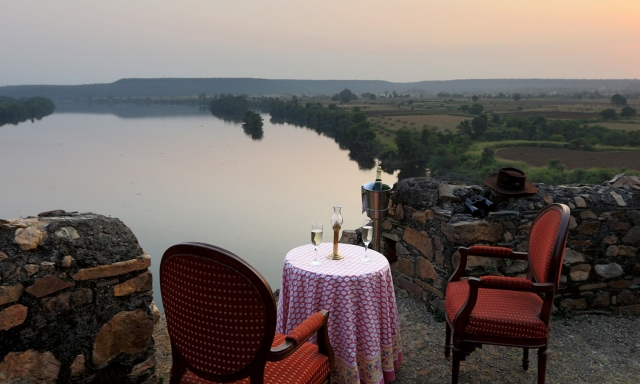Cape Town Canters
Sitting on my couch in the luxurious Table Bay Hotel looking at the sailboats and sloops cruising on the azure...
Subscribe to the newsletter and you will know all about my latest escapades and adventures.

Close your eyes and think of Rajasthan – deep beige sand dunes shimmering against a blue sky or golden fortresses bathed in sunshine will probably be the first frames to capture your imagination. If I say, how about watching brooding clouds pouring nature’s nirvana on a parched city or a dry and rugged riverbed coming alive with a flowing brook? Refreshing, wouldn’t it be? – There is something special about the monsoons in Rajasthan. When rain comes down on the dusty lands baked in the oppressive Indian summer, it’s not only the brown surface that turns verdant green but also the joy on the face of the locals that touches your heart forever. No wonder, palaces have been built here to watch the dance of the clouds and songs have been written in the glory of the monsoons.
Why to go to Rajasthan in the Monsoons?
My first trip to Rajasthan was during the rainy season and I returned happier on multiple aspects. The rains in Rajasthan are not exactly torrential downpours we get to see in a Mumbai or a Kerala. It’s more like drizzles with the occasional heavy shower. So the possibility of getting your trip ruined due to rain is close to nil.
Beat the Crowds
Monsoons are not the obvious choice of season for many travelers. So if you want a bit of exclusivity in an extremely popular destination, go there during the off-season. For Rajasthan, it is the time when it rains.
Lively Locals
It’s the time of fun and frolic for the people of Rajasthan. You can fancy a chance of witnessing the traditional Goths (picnics with cooking in the open). If you are lucky you might be invited to join in, like I was.
Discounted Prices
No trip to Rajasthan is complete without a stay in one of the heritage hotels made out of the palaces and Havelis of yesteryears. The monsoon season is a lean time for these hotels and they generally offer a good 30-40% discount on the base tariffs – best time to find a deal without burning a hole in your pocket.
Here are the 5 ways to make your monsoon trip to Rajasthan special:
Explore the less-trodden Bundi
The Palace of Bundi had captured the imagination of Rudyard Kipling in his Letters of Marque. He wrote “Jeypore Palace may be called the Versailles of India; Udaipur’s House of State is dwarfed by the hills round it and the spread of the Pichola Lake; Jodhpur’s House of strife, gray towers on red rock, is the work of giants, but the Palace of Bundi, even in broad daylight, is such a palace as men build for themselves in uneasy dreams– the work of goblins rather than of men”
Bundi still doesn’t quite make it to the itinerary of the average traveller, so its less-trodden alleys still holds the medieval charm.
Check out the magnificent murals of Bundi miniature paintings in red, golden and blue at the Chatramahal or appreciate the grandeur of Kipling’s Palace of Bliss (Sukhmahal) – Bundi will take you into a time warp.
Stay at the royal Hadoti Palace (http://www.hadotipalace.com/) or the Haveli Braj Bhushanjee(http://www.kiplingsbundi.com/hotel.htm) to catch a glimpse of Bundi’s glorious past.
Go bird watching in Keoladeo National Park
Home to over 350 avian species, the Keoladeo National Park is a year round destination for bird watchers from around the world. This World Heritage Site, formerly known as the Bharatpur Bird Sanctuary is only 200 km away from the national capital and can be visited as a day trip or as a part of a weekend trip.
Stay at Bharatpur Forest Lodge(http://www.bharatpurforestlodge.in/) to get up to the chatter of chirpy birds amidst lush green surroundings.
Teej Festival at Jaipur
Teej Festival is held every year during the month of July/August. It marks the advent of monsoon and is celebrated widely by the married women of Rajasthan.
They dress up in colorful clothes and jewelry to worship Goddess Parvati. With henna decorated hands, they swing on jhulas fixed to branches of large trees, singing the special Teej song.
In Jaipur, a spectacular procession featuring an idol of the Teej Mata (Goddess Parvati), winds its way through the lanes of the Old City. It comprises of decorated elephants, horses, camels, antique palanquins, dancers and bullock carts pulling cannons. A bit of everything really!
Rediscover the Lake City, Udaipur
There aren’t too many cities in Rajasthan that can boast of a Monsoon Palace, Udaipur though, proudly hosts one. The Sajjangarh Palace, popularly known as the Monsoon Palace – was built by Maharana Sajjan Singh of the Mewar dynasty in 1884. The palace, perched on top of the Aravalli Hills provides panoramic views of Udaipur city and the surrounding greenery.
Udaipur’s lakes also come alive during the monsoons and its one of the best times to visit the city.
Stay at the Jagmandir Island Palace (http://www.hrhhotels.com/Grand_heritage/jagmandir_Palace/index.aspx), where you can spend hours gazing across Lake Pichhola and pamper yourself to lavish buffets and musical soirees.
Experience Royalty at Bhainsrorgarh
A picturesque drive away from Kota, almost bordering Madhya Pradesh is Bhainsrorgarh Fort ( www.bhainsrorgarh.com), a heritage boutique hotel perched on a cliff overlooking the Chambal River. Watch the rain clouds hover around the verdant forests of Chambal as you sip your tea lounging on one of the palace verandahs.
Bhainsrorgarh is an explorer’s haven. You can row out to the river island for a picnic lunch or hike to the 9th century Badoli temples on the non rainy days. When it rains its better to get tucked under the Jharoka of your suite with the river and a sublime scenery at a touching distance.